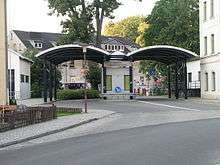Czech Republic–Germany border

Border crossing point between Sebnitz, Germany (foreground) and Dolní Poustevna, Czech Republic (background)
Border stone on the mount Třístoličník/Dreisesselberg
The Czech Republic–Germany border is the international border between the Czech Republic and Germany. It forms a 815 kilometres (506 mi)[1] arc extending from Austria at the south to Poland at the north.
Rivers
Several rivers cross this border, or form portions of it. These include:
- Chamb (Czech: Kouba)
- Pfreimd
- Wondreb (Czech: Odrava)
- Ohře (German: Eger)
- Regnitz
- Weisse Elster (Czech: Bílý Halštrov)
- Natzschung (Czech: Načetinský potok)
- Floha (Czech: Flájský potok)
- Wilde Weißeritz (Czech: Divoká Bystřice)
- Müglitz (Czech: Mohelnice)
- Biela
- Elbe (Czech: Labe)
- Spree (Czech: Spréva)
- Mandau (Czech: Mandava)
- Lausitzer Neiße (Czech: Lužická Nisa)
History
The border comes from the old border between German Empire and the Austrian Empire.
In the period 1945-1990, the border formed part of the Iron curtain and was heavily fenced and strictly guarded.
The Czech Republic joined the Schengen Area in 2007. This meant that all passport checks were removed along the border in December 2007. The limitations on Czechs working in Germany expired in April 2011.
See also
Notes
- ↑ "CIA – The World Factbook – Germany". The World Factbook. Central Intelligence Agency. May 31, 2012. Retrieved 2012-05-31.
Further reading
- "Scientists looking for hidden volcano on Czech-German border". Prague Daily Monitor. February 12, 2007. Archived from the original on 2007-09-02. Retrieved 2008-10-04.
- Mastalir, Linda (October 6, 2006). "Czech – German border crossing sees increased traffic". Radio Praha. Retrieved 2008-10-04.
- Zich, František (1998). "Germany and the Germans in the Attitudes of People Living on the Czech-German Border" (PDF). Czech Sociological Review. Ústí nad Labem: Academy of Sciences of the Czech Republic. Archived from the original (PDF) on August 24, 2005. Retrieved 2008-10-04.
- Asiedu, Dita (July 30, 2002). "Can Britain expect to see a new wave of Czech Roma asylum applicants?". Radio Praha. Retrieved 2008-10-04.
External links
| Wikimedia Commons has media related to Czech Republic-Germany border. |
- Border lines Germany – Czech Republic (railways)
This article is issued from
Wikipedia.
The text is licensed under Creative Commons - Attribution - Sharealike.
Additional terms may apply for the media files.